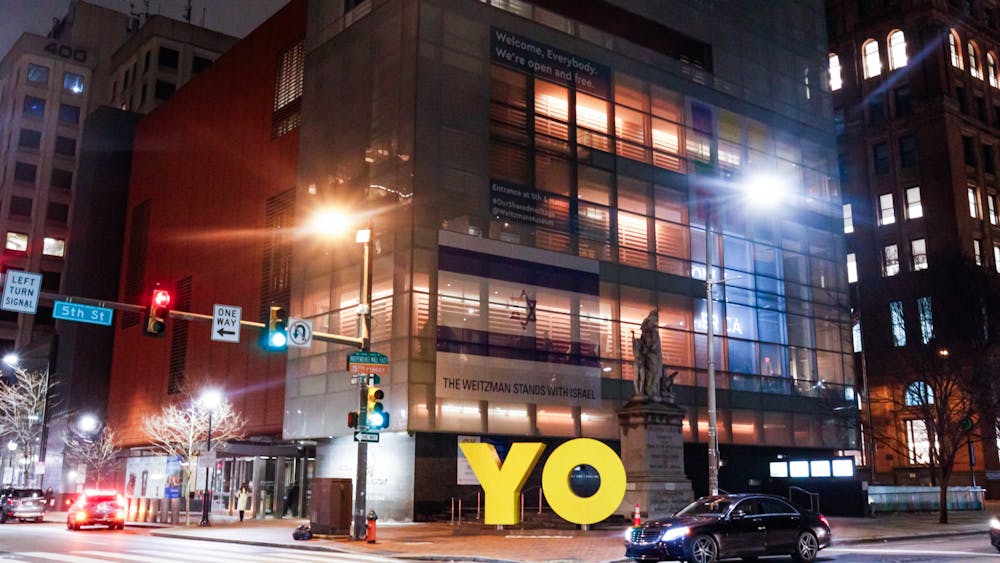Philadelphia’s reputation as the United States' “Cradle of Liberty” has long endured: As the nation’s primary capital, this city oversaw America’s forefront discourses on self governance. Likewise, Independence Mall’s attractions recollect momentous events in the democratic republic’s formation—the Constitutional Convention and Second Continental Congress. Mediating 5th and 6th streets, this national historic landmark enlightens visitors of all ages and backgrounds. Plus, what elementary schooler doesn’t enjoy subverting each “DO NOT TOUCH” sidenote, or photobombing Liberty Bell selfies?
Just south of this historic core stands the Weitzman National Museum of American Jewish History, nestled near the intersection of 5th and Market streets. A quick glance reveals Deborah Kass’ recently installed "OY/YO" statue—cleverly illustrating a Philadelphian–Yiddish catchphrase and palindrome. This piece abuts Moses Ezekiel’s Religious Liberty, whose marble sculptures render emblems of justice. The immense delicacy surrounding these monuments only continues into Weitzman’s main building, whose glass panels afford the ultimate Philly skyline view.
Superficially, this museum’s relative location appears odd. Its neighboring institutions—Independence Hall and the National Constitution Center—symbolize the “birthplace of America.” These sites document the cultivation of patriotic identity. In contrast, Weitzman’s demographic focus is not the general post–revolutionary citizen, but rather one ethno–religious group. Yet, Weitzman’s portrayal of the Jewish–American narrative exemplifies “the freedoms to which Americans aspire”—reflecting the intentions of lead architect James Polshek.
Weitzman’s core exhibition typifies reverse chronological organization. Its uppermost level—“Foundations of Freedom”—begins in 1654—dating the earliest recorded arrival of Jews in New Amsterdam. As its moniker suggests, this gallery conceptualizes these pioneers’ newfound religious freedoms in America. Oil paintings depict warships carrying settlers to coastal cities. These ports, such as Charleston, decreed private worship laws for non–Christian communities. Yet, this exhibition simultaneously reveals how newfound Jewish communities influenced broader historical events. One room highlights correspondence between James Madison and Haym Salomon, as a Revolutionary activist financing troop uniforms. Walk farther, and one will arrive at the coats of Civil War military assistants Jacob Solis–Cohen and Alexander Hart. After observing this entire floor, visitors can grasp how Jews’ fight to receive democratic protections anticipated their participation in other political battles.
Upon descending the staircase, visitors can travel further into modernity. The museum’s third story, “Dreams of Freedom,” presents relics of accelerated Jewish United States immigration from 1880–1945: a mountain of trunk suitcases, dozens of self portraits, and family heirloom collections. Complementing these artifacts are immigrant pioneer stories, recounting the family businesses of urban slum residents. Of course, smoked salmon enthusiasts should explore this floor’s “Making America Home” subsection, showcasing the original Steinberg’s Dairy Restaurant and Samuel’s Delicatessen logos. Additionally, this exhibit displays the calamitous reality of boarder homes—five family members living together in singular, 300–400 square foot rooms. While obvious bleakness encompasses many of this floor’s anecdotes, visitors can also watch recordings of comedic performances from groups like the Three Stooges.
Interestingly, “Choices & Challenges of Freedom” highlights intersectionality as a quintessential component of Jewish–American history. Following the antechamber are vintage photographs picturing Jewish participation within the 1965 Selma Civil Rights March; Betty Friedan’s leadership of the National Organization for Women also receives tribute. These instances represent the museum's assertion that “after attaining American freedom, Jews [felt obligated] to seek social justice for all citizens.” Furthermore, this floor synthesizes Jews’ increasing role in other activist movements with their widespread flock to suburbia—illustrating the rise of schools and summer camps devoted to Torah study. Finally, prepare yourself for the largest collection of pins with Hebrew transliterations of U.S. president names.
The lobby’s Ed Snider Gallery captures the epitome of contemporary Jewish influencers. Here, a bilateral screen panel constitutes the “Only in America” Hall of Fame. This slideshow rotates daily among the honorary society’s inductees, ranging from Barbra Streisand to Golda Meir to Louis Brandeis. A voiceover depicts each individual’s rise to stardom as still pictures of their contributions flicker across the screen. Bordering this Hall of Fame’s main slideshow are artifacts such as Sandy Koufax’s LIFE cover, Estee Lauder’s preliminary oils, and a lifelike statue of Stuart Weitzman—Penn Weitzman School of Design’s namesake.
Finally, no museum day is complete without a gift shop visit. Weitzman’s store is an emporium of holiday decor—a monopoly on every type of dreidel and kiddush cup possible. Behind the bookshelves of yenta literature, one will find abundant sock pairs and shirts repping the classic “Nice Jewish Boy” mantra. If you’re feeling rather punny, then a Yo Semite T–shirt may be up your alley. Of course, a good pair of Freudian slippers will complement your around–the–house loungewear.
Truly, this museum has something in store for everyone. Whether you’re a history enthusiast or neighborhood friendly aesthete, Weitzman’s anecdotes offer a fresh perspective. After all, as Levy’s Bakery once said, you don’t have to be Jewish to love bagels and kosher pickles!

